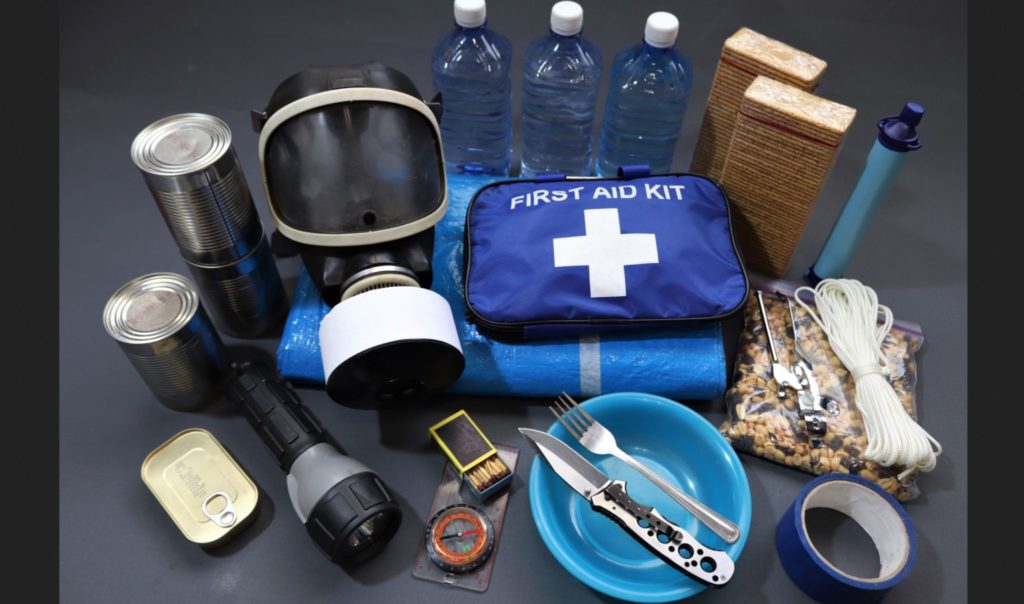 By Toby Cowern
By Toby Cowern
The 7 Pillars of Urban Preparedness is an introductory course that Selco and I teach. This is a foundational module that we refer to often because so much is built from these seven pillars. Selco and I created this framework to hang things in a logical sequence.
When Selco and I first met we shared our teaching material. After sifting through it all we found we had a massive volume of material with very little structure. People were having to process the information and somehow compartmentalize it in their own minds. They could not keep up with what we were teaching in the moment because they were still trying to sort out the previous information. We realized we needed to build structures for people to hang information on.
The preppersphere desperately needs that structure. As the sphere expands, without these structures, the information becomes more and more fragmented and people do not quite know what to do with the information they are given. The 7 Pillars are strong foundational pillars designed to help them with that and to help build resilience.
Please remember this crucial piece of advice:
These pillars are meant to be built together, incrementally, and consistently so the main structure stays level. You don’t want to build one pillar to its highest possible height when you haven’t yet started on the other 6.
What are the 7 Pillars?
- Pillar One: Water
- Pillar Two: Shelter
- Pillar Three: Fire
- Pillar Four: Food
- Pillar Five: Signaling | Communication
- Pillar Six: Medical | Hygiene
- Pillar Seven: Personal Safety
Pillar One: Water
Water is absolutely vital. Most of us probably already know that. However, what we see consistently is we struggle to contextualize the absence of something. Particularly water. Many people just can not fathom a world without freely available water. Even though academically we know it is possible there may be a time when we are without water, we viscerally don’t feel it.
We tend to avoid prioritizing water and only make a token effort. We think we can just go buy a couple of cases of bottled water, put it in the corner and “Yay me. There’s my water. Done.”
Don’t get me wrong, that’s a good start. But that is woefully insufficient. Not only in terms of actual resource, but in strategic mindset or proper planning for this preparation. We must take into consideration reasonably foreseeable problems. Is it reasonably foreseeable that there can be an interruption to our water supply? Yes, and it happens daily somewhere in the world. It doesn’t just mean the tap doesn’t work. It could also be the water is contaminated.
If we fail to keep up our intake of water, we can experience significant problems very fast. A lot of people in survival training talk about the rule of threes: Three minutes without oxygen, three days without water, three weeks without food. Some even add in 3 hours without shelter, which is environmentally related.
I want to challenge this because it gives a total false sense of security.
Yes, you can go three days without water before long term internal organ damage occurs. But, in just a few hours without water you will begin feeling the detrimental effects of dehydration. Your mental processes will become compromised. You may not be deadly dehydrated, but you will start to make stumbling-bumbling bad decisions. So, you may just die by making a stupid decision because of your compromised mental state.
Please do NOT treat this with token effort. We must understand how important water actually is.
Related: The Prepper’s Water Survival Guide
Pillar One-Water: Actionable Point
The first block of this pillar is to have a water supply stored and ready to go. You will need to calculate your household water requirement. Ideally, you want to aim for a robust two-week supply of water. This is something that’s way better to overestimate than underestimate.
- Calculate two liters per person in your household, per day of water as a minimum. This should come to a half gallon per person.
- Based on that number calculate your household requirement for one week minimum, two weeks ideally.
Household requirements means the people that are present, and the people that are possible. In the event of a crisis, is someone going to be coming to you? You need to factor them in and also factor in pets and livestock and animal effects.
The second block of this pillar addresses hygiene, whether that be in terms of flushing toilets, washing clothes or washing bodies. You want to have that buffer zone.
- Calculate five liters per person in your household, per day. This should be one and a quarter gallons per person.
- Based on that number, calculate your household requirement for one week minimum, two weeks ideally.
It is crucial that you look forward to the next stage. Perhaps you will need to have enough water for longer term, or your water may become compromised. You will want to factor in your ability to collect, transport, treat and store water. You need to think, “Where else could I go and get water from? What can I collect it with? How do I get it from where it is, back to me? How do I treat it to make it safe? How do I store it?
If you have collected water in a container that has not been treated, the container will become contaminated. You do not want to put your safe, treated water back into an untreated container. Make sure you have another container or system.
Pillar Two: Shelter
Thinking in terms of wilderness survival shelter, it would be: what resources can be discovered or pulled from the landscape to build a suitable structure to shelter against the elements here? Urban preparedness is going to be different.
Fundamentally, your shelter needs to protect you from environmental hazards. For me living here in Northern Scandinavia, we go deep into extreme winter – double-digit negative temperatures, consistently with heavy snowfall, heavy winds. Heating and insulation of houses and whether cladding and weatherproofing is a huge priority of constructions here.
All of you are all over the globe and I don’t know what region you live in or what weather you live through. But the common thought here should be: is your shelter resilient to your weather in general. Hopefully, your house deals with the climate that you’re used to living in. (That would be unfortunate if it weren’t.) And, also to the extremes of that climate and any extreme weather events that could happen.
Get Non-GMO storable food HERE!
Environmental threat is not just about the weather, it is also about the demographic you live in. Do you live in a densely populated region or a sparsely populated region? More densely populated areas have more people. More people means there will be more competition for resources. It can also mean the area can become more prone to violence.
Density does not just refer to people. You have to consider animals.
It’s been interesting to look at areas that have gone into lockdown due to the pandemic. The ecosystem has been interrupted because many animals were used to feeding off human garbage. (Dumpsters at the back of restaurants type stuff.) Animals are becoming increasingly out of control and problematic because those normal food resources aren’t there. Animals associate people with food and will take risks to get closer to people to access that resource. Your shelter needs to protect you from animals as well.
Pillar Two-Shelter: Actionable Point
Think about layout in terms of actual use vs intended use vs potential use. A shelter needs to function normally and it needs to function in extremes. Not only during environmental threat, but also the additional burden of more people.
For example: you may live on your own, or you may live with a partner and have a small family. What if, out of necessity, additional family members must be included. How will your shelter now cope with that? Do you have enough beds and bedding? Do you have enough cutlery and crockery if you need to house and feed more people? Or, you may have a categorical red line of no one’s ever going to come into my property, let alone stay on, or to stay here for a longer period of time.
Related: SELCO: What to Do If Unwanted People Show Up at Your Door When the SHTF
Many of us are used to simply walking in through the front door or the back door. But let’s just put it in pandemic context. If an airlock is needed to create a decontamination route into the premise, how will you re-roll to do that? How am I changing? Are you going into a garage, stripping down, cleaning and putting on fresh clothes? What are you options for entering the residence then?
That is viral or pandemic specific, but there can be other issues.
For example, you are out dealing with extreme weather events getting really wet, muddy, dirty and stinky. That same sort of decontamination process needs to be factored in. How do we transition from outside to inside safely and securely? How do we transition from inside to outside in the reverse manner?
The big one is: what if the infrastructure gets compromised? What if the water stops running? What if the electricity stops working? If there is a gas supply, what if it runs out or it’s switched off? What are the alternatives now to keep the shelter functioning? And what’s the longevity of those? If you’ve got a small, backup gas cylinder, how long does that work in your heating system?
Remember this: one to two weeks minimum is a healthy caution. You should be thinking about if the need to heat, cool, ventilate and light your shelter for one to two weeks MINIMUM. This is not to say don’t plan for longer, if you want to plan for one month, three months or six months, that’s perfectly fine.
Pillar Three: Fire
This pillar includes alternative heating and cooking means as well as fire protection and fire suppression.
If electricity is off, if the stove doesn’t work, if the heating is shut off, what do you have as an off grid alternative for that? Do you have a camping stove, a little gas cooker or the ability to improvise and adapt for what is suitable for your environment?
As the system starts to get squeezed and the pressure begins to show, emergency services are potentially re-prioritized. You will then need to be your own fire department, your own nursery, your own school, your own pharmacy, your own hospital. All of that infrastructure and resource you’re used to accessing may not be available to you for some time. As the situation gets more serious you must increasingly become risk aware and prepared to manage risk.
Pillar Three-Fire: Actionable Point
Possible scenario: The electricity has gone out. You are now using candles for lighting, a camp stove or gas cooker to cook on. This is increasing the fire hazards in the home. At the same time there is going to be significantly delayed response, or no response, from emergency services.
Make sure you have smoke alarms in place, fire blankets and accessible fire extinguishers. Aside from very small children, everyone needs to know where these things are and how to use them. This is very important. If you are not there in that moment, whoever is there must know how to adequately suppress a fire before it gets out of control.
Another thing to take into consideration is what your residence is made of. If you are living in a brick apartment, great. However, if you live in a wood house insulated with sawdust it will they go up in flames like a tinderbox.
Pillar Four: Food
We are terrible creatures of habit.
We buy the food we are used to buying with no regard to practicality. Especially if we eat fresh every day. Two weeks of fresh produce in your fridge is all going to by mushy and rotting within three days. When we break out of our habits because of panicked herd mentality we find that we have stocked up on all the wrong things.
To those of you who may have already gone out and bought 200 kilos, 450 pounds of pasta: what are you gonna do with it? After eating that for four meals straight, you are going to be done. Cooking and cleanup are fine if everything is running perfectly. But what if the grid is compromised?
Shelf Stable and long-term food do not require any sort of special storage considerations, refrigeration, freezing or particular temperature. You need to ask yourself: do I have the means for preparation? Is this something I can tolerate? Let me let you in on a little secret: No One Like MRE’s. They are a necessary evil with a few rations that are okay. But that is as good as you’re going to get.
RELATED: A One-Month Shelf-Stable Food Menu Your Family Will Love
You have to try and keep familiar routines as much as you possibly can. Mealtime cannot be a war-zone. Throwing away a weeks’ worth of food is not survivable.
Pillar Four-Food: Actionable Point
While the stores are still open and online ordering is available, get what you can. Try to maintain a well-rounded diet. Buying a million of one thing is not going to work. To the best of your ability add variety. In my family we are fortunate to be able to create Indian food. With four base ingredients and 10 different spices we can have 30 different meals.
Don’t forget the snacks, it’s going to be a stressful time. Comfort snacking can bring a profound sense of relief. Just don’t buy 400 bags of chips and nothing with any substance.
The big thing to factor in is ease of preparation. Whatever you buy, just imagine if you’re limited on water or the gas or electricity is off. How easy is it to prepare? Things that require little or no preparation should be very, very high on your list.
Related: Prepper’s Pantry
Pillar Five: Signaling | Communication
Signaling and Communication are two complementary parts of Pillar 5. However, they have different meanings. Signaling relates to the devices or hardware used. Communication relates to the effectiveness and our own level of competency with the tools or platforms we intend to use.
Typically many of us get tripped up by only thinking of the gadgets and hardware. Just having walkie-talkies with batteries in them is not enough. Effective communication requires the competence and understanding of the correct use of that equipment, and the actual means to communicate your message unambiguously and with clarity to the other party or parties.
Pillar Five-Signaling | Communication: Actionable Point
Your aim here is to give yourself as many options as you can while also being effective, clear, and concise.
Ask yourself the following:
- How many people am I dealing with?
- What would be the best form of communication under the current situation?
- How far do I need my communications to travel?
- What kind of signals can I use to convey the messages quicker?
Here are examples of what you can use and how for effective communication.
PHONES: Set up a “Family Crisis Group on your phones. Instead of having to send the same message to 10 different people 10 different ways, you can put it all in one chat. This way everyone gets information at the same time and anybody can reply on the same thread and update.
PEN AND PAPER: Think a little more traditional. Not everything has to be done on a cell phone or computer. Physically write out lists, notes, whatever is necessary. This could come in handy if, let’s say, you have someone quarantined in your home. Passing notes to them on their food trays could be very beneficial. The quarantined person could then respond in the same manner when the food tray is returned.
WHITEBOARD: One way to transcend communication barriers is the use of a whiteboard. You should be able to pick up a few whiteboard packs, that include the markers and erasers, inexpensively. Having the ability to write notes and even communicate through glass if someone has self-isolated behind triple glazed glass and you’re on the other side is hugely beneficial.
WALKIE TALKIES: You could also consider ham radios, but for now, let’s stick to the more basic alternatives. Walkie talkies are great to have, especially if your network coverage is spotty or you are in a black spot. I used mine extensively when the kids were smaller. When I would go out to do things, the kids would stay in the house. Having the ability to check in on them and they could respond made them not so nervous.
You have to be broad in your approach to this one. Don’t narrow yourself down to simply choosing the devices or hardware.
Pillar Six: Medical | Hygiene
Medical and hygiene is another double-barreled pillar. Medical is effectively the reactive side of this pillar. For example, people have gotten injured or I’ve been hurt, and I need to have the equipment, tools, means, and knowledge to treat, triage, prioritize and deal effectively with those injuries. Not only in the short term, but potentially in the long term.
Hygiene is the preventative side of things. As the grid softens, or potentially goes down, hygiene and sanitation routines are easily compromised. If the toilets aren’t flushing, if the water is not running to wash your hands it becomes easy to overlook those habitual routines. Lack of sanitation, lack of good hygiene practice, is probably going to damage more people than a gunshot wound.
Often, we focus on the tactical, the cool side of medicine, neglecting the basics. If we don’t have the means and the ability to manage our bodily functions and waste immediately and effectively in the short term or long term, that’s far more likely to cause problems faster than some of the other stuff.
Pillar 6-Medical/Hygiene: Actionable Point
Begin by looking at your ability to improvise and adapt: For instance, if you don’t have a specific piece of medical gear, dressings, or bandages, what can be used to improvise and adapt? What is the critical equipment or supplies that just cannot be substituted? Bottled oxygen is a great example: if you’ve got somebody that needs supplementary oxygen, there’s almost no way to effectively substitute that. You will also have to analyze what parts are needed for critical equipment. You might have the bottle oxygen, but if you don’t have the tube, adapters, and connectors then you’ve got yourself a big problem. Also very important is the mechanical knowledge needed to repair any of the equipment you may have.
Medicines or pharmaceuticals: You need to know what is critical and is there a specific way of administering it. If it is tablet form that is relatively easy. But you need to know whether you’ve got to mix it in a vial, or it needs to be in a suspension, or requires a certain measurement or must be delivered using a specific method. And, you need to know how to do all those things and have the backup supplies necessary to do so.
Alternatives for sewage and waste: Almost a third of the planet does not use toilet roll at all. There are alternatives. When I was in the stores a few days ago all the toilet roll was sold out. But there were wet wipes, napkins, and kitchen rolls. You do not need a toilet roll to wipe your ass.
*Common knowledge: Do NOT flush wet wipes. They will clog your drains.
If the toilet won’t flush, but you’ve got plenty of greywater accessible you just pour a bucket in that toilet and that create the flushing action. Most modern toilets are designed as a gravity-fed system. If your toilet entirely stopped working, do you have alternatives to that? Get some heavy-duty trash bags to line the toilet with and collect the physical waste. Make sure you have a suppressor to top it off with, like cat litter. Tie it off and dispose of it safely.
RELATED: How to Make a Kitty Litter Toilet for Humans
At the very least, have a well-stocked first aid kit:
- Address any medication concerns for everyone. If you’re on routine medication, you need to get as many of those as possible. Talk to your healthcare provider about accessing that.
- If you or anyone else has allergies: at least two to three months of allergy medication.
- Think about your non-medical needs: this can be things such as mosquitoes. They may not be a problem just yet, but if you are in an area where they will be, make sure you have supplies needed for those things now.
- Tummy issues? Diarrhea? Cough? Cold? Irritated Eyes? Get the over the counter medications for those NOW. No need to stockpile. Just get ahead of the curve.
Pillar Seven: Personal Safety
Originally in the Seven Pillars model, the seventh pillar was self-defense. We have added to that and expanded into Personal Safety. Self-defense is crucial in that you need to know how to physically protect yourself in an attack. We have expanded this pillar to include minimizing the risk of any environmental factors that you may come into consideration with.
PPE definitely forms a part of this pillar. PPE includes gloves, masks (can be disposable or long lasting), safety glasses, defenders, specialty clothing, protective footwear, cold weather gear. Looking back on the courses from one to five years ago talking about the need for PPE people put in the token effort. They would have a box of 5 or 10 masks thinking they would not need more. Now, we have a pandemic waking us up to the fact that we can go through a large amount of disposable PPE in a very short period of time. General preparedness or true preparedness is all about that bigger picture perspective, not fixating on one thing.
Another thing to consider is your general way of dressing. You want to think about not standing out in environment you’re in. Just walking or driving through and not really getting noticed or having attention drawn to yourself is highly desirable.
Pillar Seven-Personal Safety: Actionable Point
Mindset: If you know there is a bad situation going down, don’t be there. That is as safe as you can be. For whatever reason, many people struggle with the “curiosity killed the cat: type thing. They just can’t help but head towards trouble just to see what’s going on. Don’t do it. The goal here is to stay alive and uninjured and as functional as possible. Avoiding trouble is a massive leap in the right direction toward that goal.
Physical purchases: you may choose to invest in tools or armaments for your personal safety. (We massively endorse this.) You also need the confidence and competence in using those tools. One example: firearms. Let’s say you have made the decision to own or carry firearms, make sure you put in the range training time and practice time. This ensures you will be confident and competent in the use of that weapons platform in the manner you mean to deploy it.
Training: The training element is crucial. Don’t get me wrong, stacking four persons deep on a door SWAT style with live fire is great fun, I love it. I do that kind of training. That is not how I plan to get my family out of my home in the instance of a home invasion. Tactically it’s completely wrong. Okay, it’s chalk and cheese trying to take that law enforcement or military application over to the civilian sphere. Make sure your training is contextual, and contextualized.
Individual Risk Analysis:
- What conditions will I be exposed to?
- How can I come to harm?
- How can I avoid or mitigate the risk of that harm?
*These questions pertain to your individual clothing, equipment, and tool selections as well. You need to know what harm may come from having, not having, use, or improper use of these items.
Build a Roof of Resilience
The Seven Pillars has stood the test of time and is more relevant and needed now than ever, in our opinion. Think of it like this: we want to build a roof of resilience, and resilience is what we want to build. Preparedness is just part of resilience. You want that roof to sit on strong foundational pillars…The Seven Pillars are designed to be those foundational pillars.













